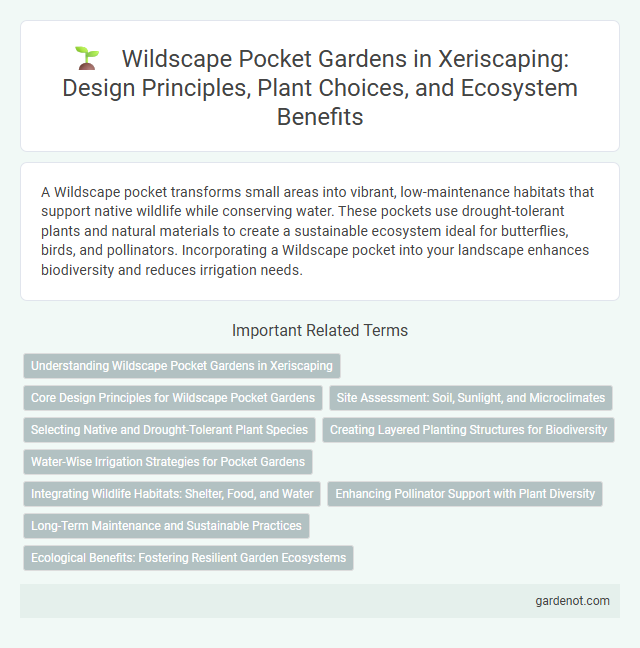A Wildscape pocket transforms small areas into vibrant, low-maintenance habitats that support native wildlife while conserving water. These pockets use drought-tolerant plants and natural materials to create a sustainable ecosystem ideal for butterflies, birds, and pollinators. Incorporating a Wildscape pocket into your landscape enhances biodiversity and reduces irrigation needs.
Understanding Wildscape Pocket Gardens in Xeriscaping
Wildscape Pocket Gardens in xeriscaping prioritize the use of native, drought-tolerant plants that thrive with minimal water, promoting sustainable landscaping. These compact, biodiversity-rich spaces support local wildlife such as pollinators and birds, enhancing ecosystem health in urban areas. Incorporating organic mulch and efficient irrigation methods reduces water consumption while maintaining soil vitality in Wildscape Pocket Gardens.
Core Design Principles for Wildscape Pocket Gardens
Wildscape pocket gardens thrive by integrating native drought-tolerant plants that support local wildlife and conserve water. Emphasizing soil health through organic mulching and minimal disturbance promotes plant resilience and biodiversity. Strategic layering of vegetation enhances habitat complexity, encouraging pollinators and beneficial insects in these compact ecological spaces.
Site Assessment: Soil, Sunlight, and Microclimates
Wildscape pockets thrive when informed by thorough site assessment, emphasizing soil composition, sunlight exposure, and microclimates. Analyzing soil texture and drainage determines suitable drought-tolerant plant species, while mapping sunlight patterns ensures proper plant placement for optimal growth. Identifying microclimates, such as shaded or wind-protected zones, refines plant selection to enhance water efficiency and biodiversity in xeriscape designs.
Selecting Native and Drought-Tolerant Plant Species
Selecting native and drought-tolerant plant species is essential for creating an effective Wildscape pocket, ensuring minimal water usage and promoting local biodiversity. Species such as purple coneflower, blue grama grass, and desert marigold thrive in low-water conditions while providing habitat for pollinators and wildlife. Incorporating a mix of deep-rooted perennials and hardy shrubs enhances soil stability and reduces irrigation needs in xeriscaped landscapes.
Creating Layered Planting Structures for Biodiversity
Creating layered planting structures in a wildscape pocket enhances biodiversity by mimicking natural ecosystems with multiple vegetation tiers, such as ground covers, shrubs, and small trees. This stratification supports diverse wildlife habitats by offering varied food sources, shelter, and breeding sites for insects, birds, and small mammals. Incorporating native, drought-tolerant plants ensures sustainability and resilience in xeriscape designs while promoting ecological balance.
Water-Wise Irrigation Strategies for Pocket Gardens
Wildscape pocket gardens thrive by integrating water-wise irrigation strategies such as drip irrigation and micro-sprinklers that deliver targeted moisture directly to plant roots, minimizing water waste. Utilizing native, drought-tolerant plants further enhances water efficiency by reducing the need for frequent watering. Soil moisture sensors and smart irrigation controllers optimize watering schedules, ensuring maximum water conservation in these compact, sustainable landscapes.
Integrating Wildlife Habitats: Shelter, Food, and Water
Creating a wildscape pocket involves strategically integrating native plants to provide essential shelter, food, and water sources for local wildlife. Incorporating diverse vegetation like shrubs, grasses, and flowering species supports bird nesting, pollinators, and small mammals while maintaining natural water features or rain gardens ensures hydration. This balanced habitat design enhances biodiversity and promotes ecological stability in urban or arid environments.
Enhancing Pollinator Support with Plant Diversity
Wildscape pockets enhance pollinator support by incorporating a diverse array of native plants that provide continuous nectar and pollen sources throughout the growing season. Including flowering perennials, grasses, and shrubs creates essential habitats for bees, butterflies, and other pollinators, promoting ecosystem resilience. Strategic plant diversity within xeriscape designs not only conserves water but also bolsters pollinator populations critical for ecological balance.
Long-Term Maintenance and Sustainable Practices
Wildscape pockets require minimal watering and natural pest control, significantly reducing long-term maintenance efforts. Utilizing native, drought-tolerant plants enhances soil health and conserves local biodiversity, supporting sustainable landscaping practices. Proper mulching and seasonal pruning further promote water retention and plant vigor, ensuring an eco-friendly garden environment.
Ecological Benefits: Fostering Resilient Garden Ecosystems
Wildscape pockets enhance ecological benefits by creating habitats that support local wildlife and promote biodiversity within urban environments. These xeriscape features conserve water through drought-tolerant native plants that improve soil health and reduce erosion. Integrating wildscape pockets fosters resilient garden ecosystems capable of withstanding climate variability while maintaining ecological balance.
Wildscape pocket Infographic

 gardenot.com
gardenot.com